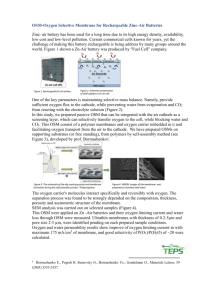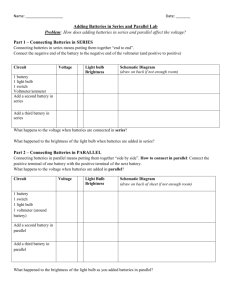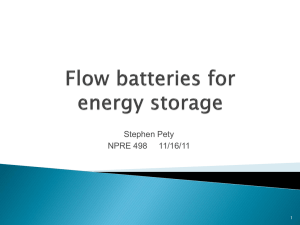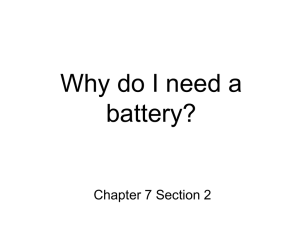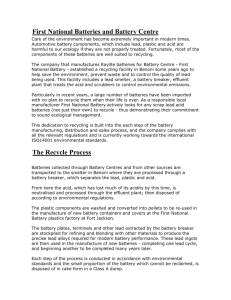Building Batteries Lab
advertisement
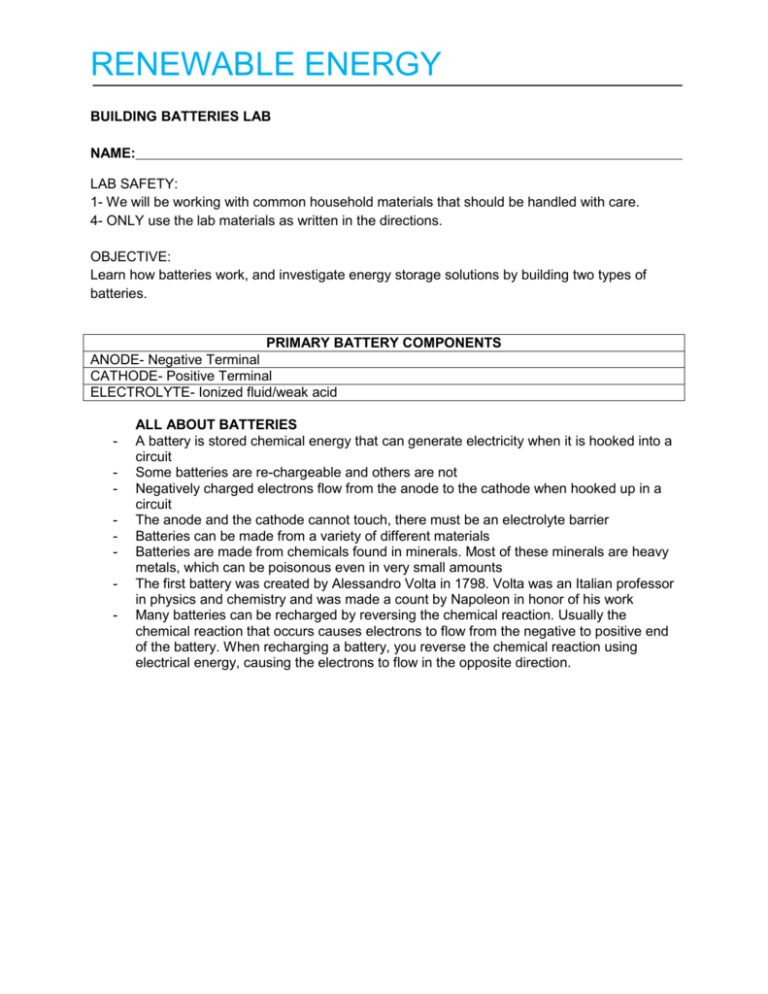
RENEWABLE ENERGY BUILDING BATTERIES LAB NAME: LAB SAFETY: 1- We will be working with common household materials that should be handled with care. 4- ONLY use the lab materials as written in the directions. OBJECTIVE: Learn how batteries work, and investigate energy storage solutions by building two types of batteries. PRIMARY BATTERY COMPONENTS ANODE- Negative Terminal CATHODE- Positive Terminal ELECTROLYTE- Ionized fluid/weak acid - ALL ABOUT BATTERIES A battery is stored chemical energy that can generate electricity when it is hooked into a circuit Some batteries are re-chargeable and others are not Negatively charged electrons flow from the anode to the cathode when hooked up in a circuit The anode and the cathode cannot touch, there must be an electrolyte barrier Batteries can be made from a variety of different materials Batteries are made from chemicals found in minerals. Most of these minerals are heavy metals, which can be poisonous even in very small amounts The first battery was created by Alessandro Volta in 1798. Volta was an Italian professor in physics and chemistry and was made a count by Napoleon in honor of his work Many batteries can be recharged by reversing the chemical reaction. Usually the chemical reaction that occurs causes electrons to flow from the negative to positive end of the battery. When recharging a battery, you reverse the chemical reaction using electrical energy, causing the electrons to flow in the opposite direction. RENEWABLE ENERGY MAKING BATTERIES LAB PART 1 BATTERY 1- COIN BATTERY PROCEDURES: 1- Using the materials provided- paper towel squares, pennies, nickels, salt water/vinegar- build a stacked coin battery 2- Test the battery using the multimeter, motor, and light 3- When using the multimeter, make sure to touch 1 lead to the anode and 1 lead to the cathode 4- Consider how to make sure that the anode and cathode are separated by the electrolyte. What materials to you have that you can use? VARIABLES: List 3 or more additional variables for this battery: 1- The age of the coin- pennies made before 1982 will have a higher percentage of copper than after 1982 HYPOTHESIS: DESIGN: Draw a diagram depicting your battery in the space below. Make sure to label each material and its function (anode, cathode, and electrolyte). RENEWABLE ENERGY MAKING BATTERIES LAB PART 1 OBSERVATIONS: Trial Number of Pennies Number of Nickels Voltage (mV) 1- Were you able to power any devices with your battery? If yes, what did you power? If not, what variable would you change in order to power something? 2- What trends did you observe during the experiment? 3- What was the highest voltage recorded? CONCLUSION: RENEWABLE ENERGY MAKING BATTERIES LAB PART 2 BATTERY TWO- ALUMINUM AIR BATTERY PROCEDURES: 1- Build a battery using the materials provided- activated carbon, aluminum foil, electrolyte (vinegar or salt water) and paper towels, and alligator clips 2- Remember to make sure that the activated carbon and the aluminum foil are separated by the electrolyte 3- Test the battery using a multimeter, and then try to power a motor or light 4- Conduct 2 trials to test your hypothesis. 5- HINTS: The paper towel is an essential component of the battery; the cups used for the electrolyte should not be used in the construction of the battery VARIABLES: List a 2 or more different variables for this battery HYPOTHESIS: DESIGN: Draw a diagram depicting your battery in the space below. Make sure to label each material and its function (anode, cathode, and electrolyte). RENEWABLE ENERGY MAKING BATTERIES LAB PART 2 OBSERVATIONS: Trial Variable- what did you change? Voltage (mV) 1- Were you able to power any devices with your battery? If yes, what did you power? If not, what variable(s) would you change in order to power something? 2- Were you able to power a light bulb? Why or why not? 3- What was the highest voltage recorded for your battery? CONCLUSION: RENEWABLE ENERGY MAKING BATTERIES LAB PART 2 FINAL WRAP UP: Identify the following for both batteries: Battery Component Coin Stack Battery Aluminum Battery ANODE CATHODE ELECTROLYTE 1- Was one battery more powerful than the other? Which one? Explain your thoughts. 2- What do batteries and solar panels have in common? 3- What role will batteries play in the future of energy storage?

